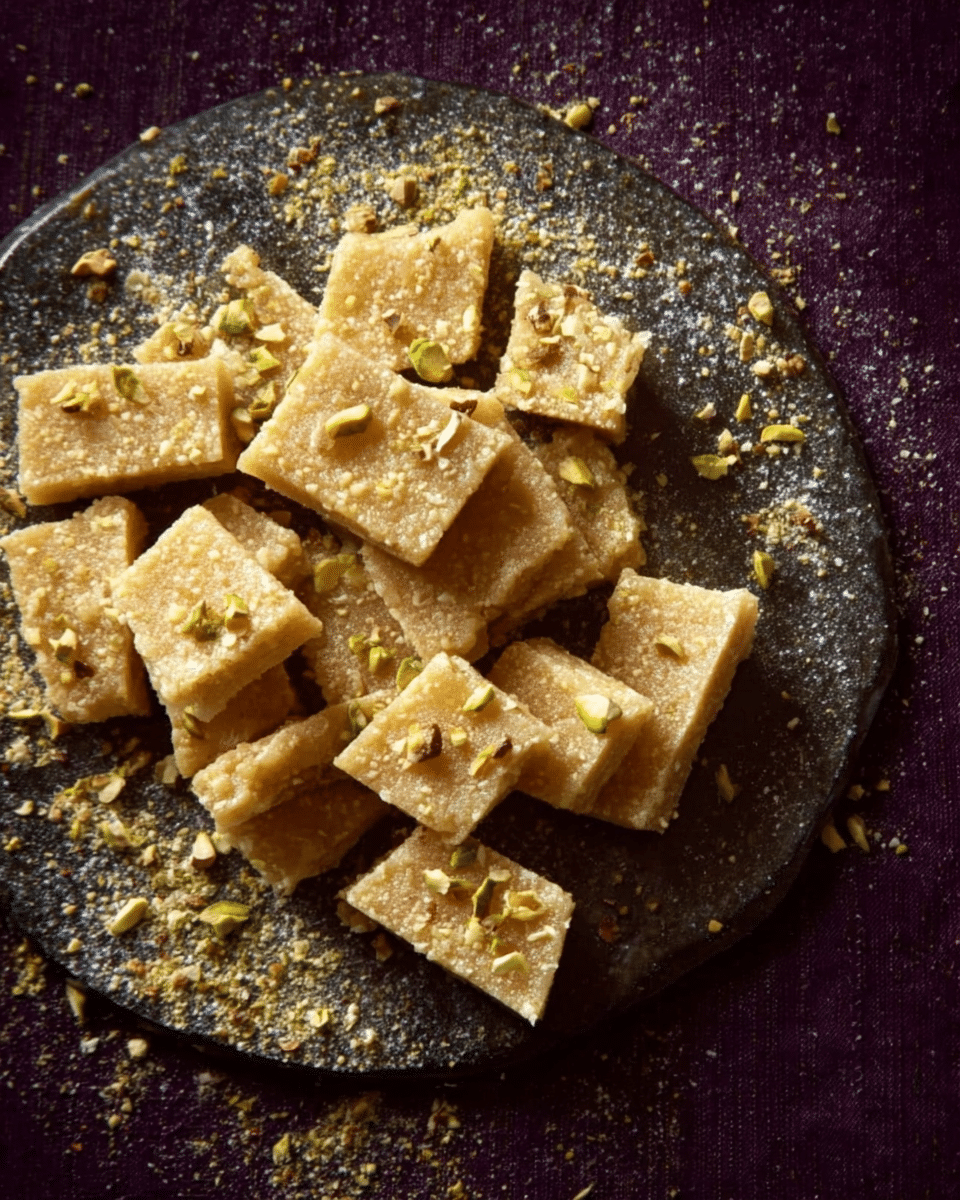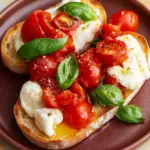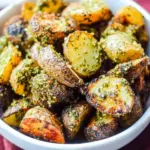The Soan Papdi, also known as Patisa, is a cherished Indian sweet with a texture that’s both flaky and melt-in-your-mouth soft. Infused with the warm aroma of cardamom and garnished with pistachios and almonds, it’s a nostalgic delight that graces every Indian celebration.
This simplified homemade version brings the magic of sweet shops right into your kitchen. It’s perfect for festivals like Diwali or Raksha Bandhan, or simply to relive childhood memories. Quick to make and endlessly giftable, Soan Papdi is your answer to an elegant yet easy Indian dessert that leaves a lasting impression.
Full recipe:
Ingredients:
-
1 cup gram flour (besan)
-
1 cup plain flour (maida)
-
1 cup ghee
-
2 cups sugar
-
½ cup water
-
½ tsp cardamom powder
-
2 tbsp pistachios, finely chopped
-
2 tbsp almonds, finely chopped
Directions:
-
Sift together the gram flour and plain flour into a bowl.
-
In a heavy-bottomed pan, heat ghee on low heat and slowly roast the flour mix until golden brown and fragrant. Remove from heat and set aside.
-
In a separate saucepan, add sugar and water. Bring to a boil until the syrup reaches a two-thread consistency.
-
Quickly pour the sugar syrup into the roasted flour mixture and stir vigorously until well mixed and the mixture thickens slightly.
-
Grease a flat plate or tray and pour the mixture in, spreading it evenly.
-
Sprinkle cardamom powder, chopped pistachios, and almonds on top.
-
Let it cool for 5-10 minutes until it’s warm but not hot. Then use a fork or spoon to stir and stretch the mixture, creating a flaky texture.
-
Flatten again and cut into squares once completely cool.
-
Store in an airtight container and enjoy!
Prep Time: 15 minutes | Cooking Time: 20 minutes | Total Time: 35 minutes
Kcal: ~210 kcal per piece | Servings: 12 pieces
Cultural and Regional Significance
Soan Papdi holds an esteemed place in Indian culinary traditions. Every region of India has its own version and presentation of this sweet. In the north, especially in Punjab and Uttar Pradesh, it’s referred to as “Patisa” and is denser and more compact. In the west, particularly in Gujarat and Maharashtra, it’s known as “Soan Papdi” and is lighter and more fibrous. Regardless of the name or variation, the sweet is considered a symbol of celebration and hospitality.
During Diwali, Raksha Bandhan, and Holi, boxes of Soan Papdi are exchanged among friends, relatives, and colleagues. It’s a common gift item, neatly packaged in golden foil boxes or decorative tins, which adds to its perception as a premium, festive sweet. Gifting sweets is an age-old tradition in India, symbolizing goodwill and joy, and Soan Papdi fits this role perfectly.
It’s also popular in South Asian communities abroad, where it serves as a nostalgic treat that connects people to their cultural roots. Imported and locally produced versions of Soan Papdi are readily available in Indian grocery stores in countries like the USA, UK, Canada, and Australia. For many immigrants, the sweet carries sentimental value, evoking memories of festivals and family gatherings back home.
Texture and Taste Profile
One of the most distinctive aspects of Soan Papdi is its texture. The sweet has a fibrous, flaky structure that’s achieved by stretching and folding the flour and sugar mixture multiple times while it’s still warm. This gives Soan Papdi its signature mouthfeel — it starts off crisp and quickly dissolves into a sugary, nutty blend that dances on the tongue. The presence of ghee not only enhances the richness but also contributes to the crumbly nature.
The flavor is equally intricate. The sweetness of the sugar is tempered by the earthy notes of gram flour and the richness of ghee. The cardamom adds a warm, aromatic undertone that lingers long after the sweet has been eaten. Chopped pistachios and almonds sprinkled on top provide a pleasant contrast, offering bursts of crunch and nuttiness that elevate the overall experience.
Modern Variations and Commercial Appeal
In recent years, Soan Papdi has undergone various transformations to cater to modern palates. Today, it’s not uncommon to find flavored versions such as chocolate, mango, rose, saffron, and even fusion varieties like Soan Papdi cheesecake or Soan Papdi truffles. These modern adaptations aim to attract a younger audience while retaining the core identity of the original sweet.
Commercially, Soan Papdi is produced by a number of leading Indian brands and confectioners. Thanks to advances in food packaging technology, it enjoys a long shelf life, which makes it suitable for export and long-distance gifting. The mass-produced versions are usually less fibrous than their handmade counterparts but still maintain the essential flavor profile and texture. Moreover, the sleek packaging, often in vibrant and festive colors, enhances its gift-worthiness, especially during peak festival seasons.
Health Considerations
While Soan Papdi is undeniably delicious, it is also rich in sugar and ghee, making it a high-calorie treat. A typical piece contains approximately 210 kcal, and though it’s fine to enjoy occasionally, moderation is key for those who are watching their sugar or fat intake. For individuals with dietary restrictions, some brands now offer versions made with jaggery or sugar alternatives, though the texture and taste may differ slightly.
On the positive side, Soan Papdi is gluten-free (when made with gram flour and no added wheat flour), making it suitable for people with gluten sensitivities. It’s also vegetarian, aligning with the dietary preferences of many Indians. Given its rich taste, a small piece can satisfy sweet cravings, which helps in portion control if consumed mindfully.
Homemade vs. Store-Bought
Making Soan Papdi at home offers several advantages. First, it allows for control over the quality and quantity of ingredients, including the type of ghee, the amount of sugar, and the use of organic or non-GMO flour. Homemade Soan Papdi often boasts a more authentic, fresher taste compared to the mass-produced variants. The process of making it, while slightly technical, can be a rewarding culinary project for those interested in traditional cooking techniques.
Store-bought versions, on the other hand, offer convenience and consistency. They are ideal for people with limited time or those looking for quick gifting options during the festive season. Many Indian families keep a box or two of Soan Papdi on hand during festivals for unexpected guests or last-minute gifts.
The Art of Presentation
Soan Papdi is as visually appealing as it is delicious. Traditionally cut into square or diamond shapes, its golden, flaky appearance makes it an elegant addition to any festive table. Garnished with chopped nuts and sometimes edible silver foil (varak), it exudes opulence and charm. When serving Soan Papdi at home, it can be arranged on a decorative thali or dessert platter, accompanied by other Indian sweets like barfi, laddu, or jalebi for a rich, indulgent spread.
For gifting purposes, decorative boxes and tins are commonly used, especially during Diwali and other major festivals. These boxes often come in vibrant colors and include festive motifs such as diyas, rangolis, or peacocks, enhancing their aesthetic value. Customized gift packs with a personal message or family name embossed are also increasingly popular, particularly for weddings and corporate gifts.
Conclusion
Soan Papdi is more than just a sweet; it is a symbol of celebration, tradition, and nostalgia. Its intricate texture, aromatic flavor, and cultural significance make it a cherished treat across generations and regions. Whether enjoyed as a homemade delicacy or gifted in a gleaming festival box, Soan Papdi continues to win hearts with its timeless charm.
From its humble beginnings in Indian sweet shops to its global presence in the homes of the South Asian diaspora, Soan Papdi embodies the spirit of Indian hospitality and the joy of shared celebrations. Its adaptability in flavor and form ensures it remains relevant in modern kitchens, while its deep cultural roots make it an enduring part of India’s culinary legacy.






